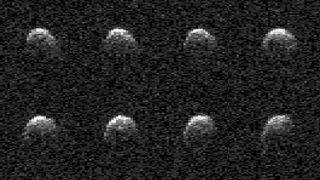
A series of images showing asteroid 2008 OS7 tumbling past Earth on Feb. 2, 2024.
(Image credit: NASA/JPL-Caltech)
A stadium-sized asteroid tumbled harmlessly past Earth this month as a powerful NASA radar system watched.
Asteroid 2008 OS7 passed by Earth on Feb. 2, 2024 at a safe distance of 1.8 million miles (2.9 million kilometers), about 7.5 times farther than the Earth-moon distance. While there was no risk of the space rock harming our planet, scientists with NASA’s Jet Propulsion Laboratory (JPL) used the sophisticated Goldstone Solar System Radar (GSSR) to produce a series of images of the asteroid as it passed by us.
The new observations helped nail down the asteroid’s size, as it had been too far away for most planetary radar systems to image sufficiently until this month’s close pass.
Related: Radar could help scientists find potentially threatening asteroids. Here’s how
Asteroid 2008 OS7 orbits the sun every 2.6 years, passing within the orbit of Venus at its closest to the sun and out past the orbit of Mars at its farthest. 2008 OS7 is designated as “potentially hazardous” due to its size and how close to Earth it passes, but it won’t come this close to our planet for another 200 years, JPL wrote in a statement about these new observations.
When it was first discovered in 2008 during a routine search for near-Earth objects (NEOs), scientists estimated asteroid 2008 OS7 to be around 650 to 1,640 feet (200 and 500 meters) wide.
Asteroid 2008 OS7 appears as a white dot on a starry background in this image by Gianluca Masi of the Virtual Telescope Project in Ceccano, Italy taken during the close pass on Feb. 2, 2024. (Image credit: Gianluca Masi/The Virtual Telescope Project)
Using JPL’s radar observations on Feb. 2, scientists found that the asteroid is significantly smaller than those initial estimates; they now believe it to be around 500 to 650 feet (150 to 200 meters) across. The new observations also confirmed that 2008 OS7 rotates at an uncommonly slow rate, completing one full rotation every 29.5 hours.
The Goldstone Solar System Radar’s DSS-14 antenna is the world’s only fully steerable planetary radar system, according to JPL. It consists of a 230-foot (70 m) antenna dish housed at the Goldstone Deep Space Communications Complex in California’s Mojave Desert and can be used to observe space debris, solar system bodies and near-Earth asteroids such as 2008 OS7.
Join our Space Forums to keep talking space on the latest missions, night sky and more! And if you have a news tip, correction or comment, let us know at: community@space.com.
Breaking space news, the latest updates on rocket launches, skywatching events and more!
Brett is curious about emerging aerospace technologies, alternative launch concepts, military space developments and uncrewed aircraft systems. Brett’s work has appeared on Scientific American, The War Zone, Popular Science, the History Channel, Science Discovery and more. Brett has English degrees from Clemson University and the University of North Carolina at Charlotte. In his free time, Brett enjoys skywatching throughout the dark skies of the Appalachian mountains.
>>> Read full article>>>
Copyright for syndicated content belongs to the linked Source : Space.com – https://www.space.com/asteroid-2008-os7-earth-flyby-nasa-radar-images
